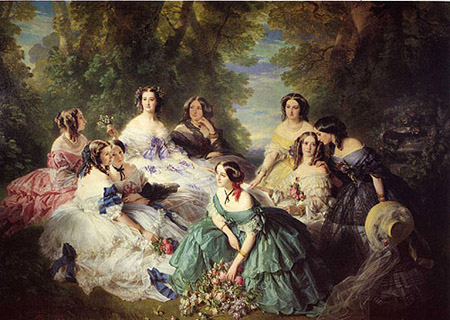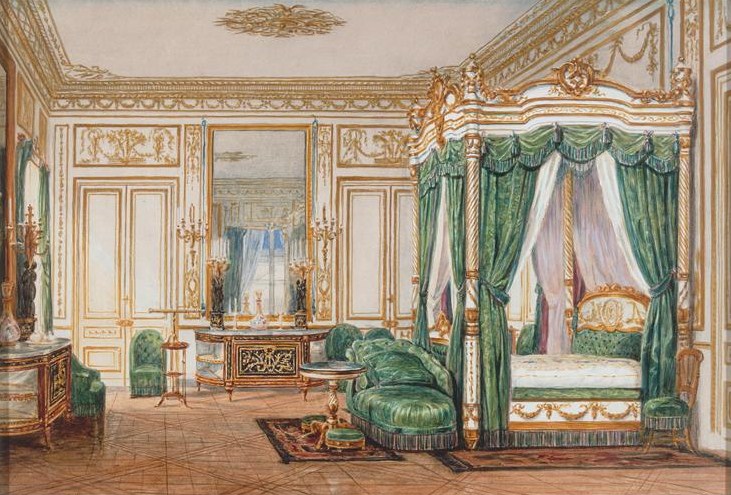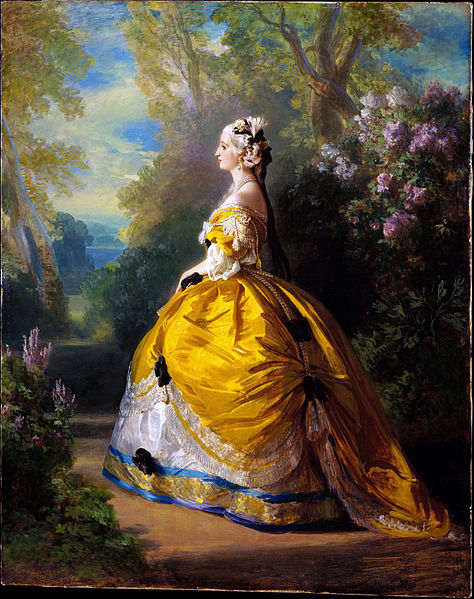 |
Empress Eugénie's bed originally from the Palais de l'Elysée 1867
today at the palais de Compiègne
original damask by Maison Mathevon et Bouvard, Lyon
photo: RMN-GP/Christophe Chavanli |
What would the Second Empire be without its swags, valances and tufting?
 |
| Alfred Stevens La Robe Jaune |
Or the Second Empire woman, without her crinolines and the double-digit yardages of fabric necessary for her dresses?
 |
| grand magasin second empire source La soie en occident |
The Second Empire in France corresponds to the dates of Napoleon III from 1850-1868, but the style continues on until 1890, roughly corresponding to the Victorian period in England. The wonderful exhibit entitled
Folie Textile, reminds us not only of the shapes and colors of the day, but that a fever raged for nearly half a century when textiles were consumed without moderation for dress and decoration.
 |
salon Princess Mathilde Saint Gratien by Charles Giraud
image souce: La Tribune de l'Art |
Textiles had been forever a symbol of opulence among the aristocracy and when the industrial revolution made them more widely accessible than ever before, a craze broke out in society close to madness. This exuberant trend spread to simpler bourgeois interiors, the perfecting of Jacquard looms, printing cylinders, and sewing machines all playing a role in spreading the joyous contagion.
 |
| Eugénie and her dames d'honneur by Winterhalter |
After a period of upheaval and economizing, this was an era of seemingly lighthearted fêtes into which was born capitalism and consumerism. Mail order catalogues circulated in abundance and Au Bon Marché, the first of the grands magasins or department stores, opened in 1852 making material desires easier to satisfy. The Empress Eugénie and her dames d'honneur set a festive tone by displaying the latest luxury creations of the textile industry with a dizzying array of gowns, changed several times a day.
 |
silk by Lamy et Giraud,design by Beuchot 1867
manufacture Prelle |
Néo-Renaissance silk lampas known as Tête de Mélusine
It's as if an immense hunger seized society, commanding it to catch up on all the bygone days when it craved cloths and other objects of which it had been deprived. So who could blame them? They fed their fever with articles imitating the Middle Ages, Renaissance, Rococo, Louis XVI - Turqueries, Chinoiseries and designs from other exotic lands. Historicizing and eclectic, they devoured the silks and chintzes, velvets and brocatelles that had the fresh savor of the Second Empire.
 |
Grand Frères Lyon, 1866
Tassinari et Chatel, Paris |
Satin curtain with a brocaded Chinese-inspired border from the hotel of the Marquise de Paiva.
 |
| cotton block print Alsace 1866, Mulhouse musée de l'Impression sur étoffes |
Print imitating embroidery to make up an Indian jeweled flower design. Note the shadows that give 3-D quality. Printed fabrics and wallpaper had a jollytime with trompe l'oeil.
 |
| Alsace 1868, Mulhouse musée de l'Impression sur étoffes |
Cotton print with fantasy 'Arabic' calligraphy. It was the spirit that counted not a true inscription.
 |
Alsace 1866
Palais de Compiènge
|
Fabrics imitating fabrics. Many prints imitated weaves and moiré undulations as in this glazed percale perse that is part of bed hanging on display. A naturalistic depiction of flowers and botanicals was in vogue. This was the the period that gave birth to the 'jardin d'hiver'.
Printed fabrics are well represented in the period and mostly considered suitable for bedrooms whereas the salon would have been more richly outfitted with brocades and velvet. A new, less expensive alternative to velvet was reps, a fabric with transverse ribs made of silk or cotton and wool that could be woven or printed to look like tapestry.
 |
Raymond Ronze 1867 Lyon
Lyon, musée des Tissus |
A very subtle and beautiful 'painted' brocatelle made of silk and linen.
Its warp was printed before weaving giving the flowers more sculptural relief with watercolor-like shading.
One of my favorites in the exhibit.
 |
portrait Napoleon III by Maison Furnion, design Auguste Malpertuy, 1855
Lyon, musée des Tissus |
The Emperor's directives, a new ease of production and an undeniable prosperity also made it possible to make textile creations of outstanding prowess. The finely sculpted effect of this cut velvet on a satin ground are astounding had me thinking of metal repoussé. It was presented as velours broderie at the World Exposition of 1855.
 |
Maison Bérard, Poncet & cie Lyon 1861
Lyon, musée des Tissus |
This silk velvet panel possibly created for Queen Victoria has an immense delicacy of rendering and fine transparent effects rarely seen in velvet. It was presented at the World's Exposition of 1862.
 |
passementrie
palais de Compiègne |
And where would we be without passementrie ? Yes, it's the icing on the cake.
Lovely, superfluous, daring.
Philippe Jullian said of the Second Empire,
Le mobilier Second Empire est provocant dans ces ornements, compliqué dans ses formes; les amours pullulent, le pastiche semble triompher; il est pourtant très original, peut-être superbe ou ravissant.
Second Empire furniture is challenging in its ornaments, complicated in its shapes;
putti abound, pastiche seems to triumph, yet it is very original and may be exquisite,
even touching.
The
exhibit site is one hour north of Paris at the
Palais de Compiègne.
An excellent
catalogue to the exhibit,
Folie Textiles, mode et décoration sous le Second Empire is available with thorough illustrations and fascinating texts (French).















































